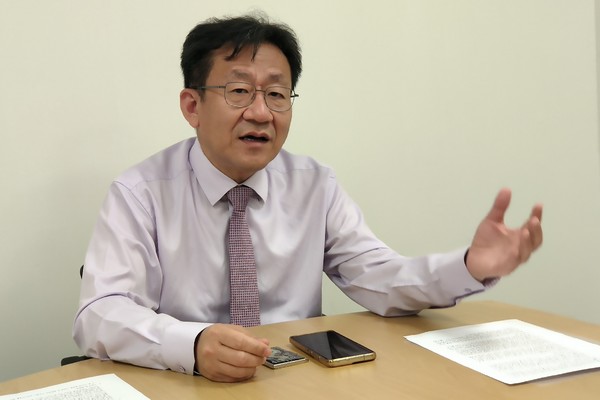Samsung Medical Center (SMC) is moving one step closer to conquering cancer using proton therapy, called the "dream cancer treatment device" for cancer patients.
SMC, which introduced the proton therapy device for the second time in Korea in December 2015 following the National Cancer Center (NCC), recently conducted its 5,000th treatment. No other medical institutions had attained it worldwide except for the Mayo Clinic in the U.S. Besides, SMC made such an achievement with two proton treatment rooms, compared to Mayo Clinic’s four.
SMC's proton therapy center, operated on a two-shift system from 7 a.m. to 10 p.m, can treat 50 patients daily. According to the hospital, the center handles about 12,000 therapies treating some 900 patients.

Recently, with the accumulation of experience in proton therapy, it has become possible to gradually increase the amount of radiation that can be irradiated daily. That reduced the number of treatments to an average of 9.7 times for liver cancer, 14.1 times for lung cancer, and 15.2 times for head and neck cancer, shortening the treatment period to two to three weeks.
SMC attributed such treatment results to cooperation based on "multidisciplinary treatment."
“Proton therapy alone cannot open a new horizon in cancer treatment,” said Dr. Park Hee-cheol, director of Proton Therapy Center, reemphasizing the importance of the role of multidisciplinary treatment.
In a recent interview with Korea Biomedical Review, Director Park said the center plans to launch clinical research to increase the effectiveness of treatment by combining chemotherapy and proton therapy.

To improve liver cancer patients’ cure rate, the center plans to conduct the clinical trial of the multimodality treatment – the combination of an immuno-cancer chemotherapy Tecentriq and target anticancer drug Avastin and proto therapy – in progressive liver cancer patients early next year.
“Proton therapy helps to gradually erase out a ‘grey area’ where surgery does not work, and it is ambiguous to use radiotherapy or chemotherapy. Our work is to eliminate the grey area using surgery, radiotherapy, chemotherapy, and proton therapy,” Park said. “That also explains why multidisciplinary treatment is important.”
Park explained that by erasing the gray area with the multimodality treatment, they could reduce the share of cancer patients who cannot be cured and suffer. In addition, as opportunities for collaboration between surgery, radiation, and chemotherapy have increased, the effect of erasing the gray areas has increased, he noted.
“After six years of treatment, I thought it would be nice to select and treat patients by finding a marker to see who would show more favorable responses to proton therapy like targeted anticancer drugs,” Park said. “There were times when a specific patient showed intense response although I prescribed in compliance with the guidelines. That shows more basic research is necessary.”
According to SMC, pediatric cancer patients, who account for 10 percent of all patients who receive proton therapy, show an increase in long-term survival rate thanks to multidisciplinary treatments.
SMC has published 59 research papers on proton therapy in Korean and international journals, and 52 were in SCI/SCIE-class journals. More specifically, 33 were about clinical studies, 26 dealt with radio-physical biology, 10 concerned liver cancer, nine regarding lung cancer, and six were related to pediatric cancer.
Proton therapy is still a ‘strait gate’ that needs payment high enough to continue
More medical institutions need to introduce the proton device to increase treatment opportunities for proton therapy. However, there are higher entry barriers due to financial burdens, making it difficult to increase treatment opportunities. He said that hospitals must put considerable financial resources into using and maintaining the device, and compensation is also necessary.
"About 80,000 cancer patients receive radiotherapy a year. About 8,000 can improve their conditions if they receive proton therapy. Aside from 900 who receive treatment at SMC and 500 who receive proton therapy at the National Center, the remaining 6,600 also require proton therapy,” Director Park said.
He noted that other hospitals need to enter into proton therapy, but additional entry is impossible now.
“I can say for sure, albeit cautiously, the health insurance authorities should guarantee payment enough to maintain the treatment facilities,” Park said. “If even SMC barely manages the center financially, it is natural that other hospitals cannot jump into this field.”
Noting that there would be a revision of the reimbursement for radiotherapy, Park said he hoped the fee would rise to a realistic level in the revised system.
Building a large-scale clinical research hub in the Asian proton therapy network
SMC plans to share know-how in operating a proton therapy center. Besides, it plans to strengthen the Asia proton therapy networking based on an agreement with the National Cancer Center to enhance cooperation in proton therapy and research early this year.
For instance, it will expand collaborative platforms with Chang Kung University Hospital in Kaoshiung, Taiwan, which sent medical trainees to SMC in 2017 and 2018, National Cancer Center Singapore, which sent trainees in September ahead of opening a proton therapy center in December, and National Cancer Center Japan.
Park also expressed his appreciation to the NCC because SMC received many counsels from medical professionals there who had already treated patients with proton devices when SMC prepared to open its Proton Therapy Center.
“Our center, based on experiences and capabilities accumulated in the course of attaining the current level, would like to provide education and share its expertise for medical institutions that are about to begin proton therapy,” Park said. “We will actively present our experiences at academic conferences and offer training opportunities so that there are more proton therapy centers in the country and help to diversify cancer patients’ treatment portfolios more substantively.”

